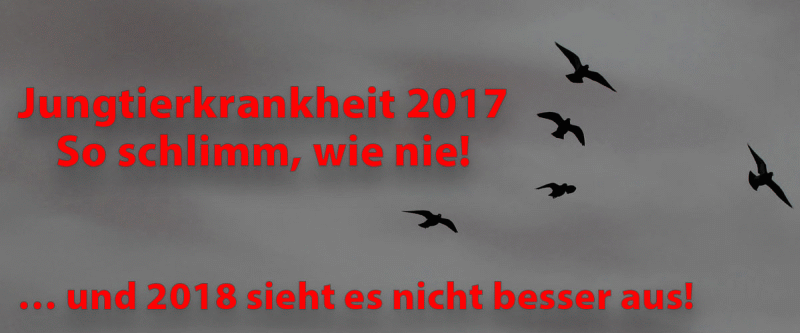The young animal disease demands high animal losses – by Alfred Berger…
- The disease was demonstrated last year worse than ever before. This negative trend continued in 2018 continued unabated ...
The young animal disease demands high animal losses
Hardly any breeder was not directly or at least indirectly affected in 2017 by the young animal disease. Who had the young animal disease itself is not in shock, knows with certainty befriended breeders that they had. Striking: The disease appeared worse than ever before with many breeders in the 2017th Affected growers reported in talks on the exhibitions of any animals lost by some 60 to 70 pups. A negative trend that continues unabated continues in 2018 ...
Numbers that can not only quickly spoil a the completed breeding year, but also the next. Especially if lower, were valuable pups that were already planned for breeding. Reason enough to feel the causes of the young animal disease more closely to the tooth to alleviate the courses or - to ensure that the disease does not break out in the coming year only - at best!
... until the outbreak of many factors coming together
today we know very well that the Young animal disease, a so-called disease factors , i.e. there are many different factors. Known triggers include stress such as a first-time insertion for exhibitions, heat and lack of water and contact with was strange pigeons, which can hardly be avoided at exhibitions. Here, Circoviruses put - probably rotaviruses - in the Factory stock and destroy them, whereby a serious weakening of the immune defense is caused. As a result, disease-causing germs, but germs can that would not cause problems for a normal immune status (optional germs), multiply explosively. In connection with the destruction of the bursa of Fabricius and the resulting immunodeficiency, these germs then become serious disease factors.
Diseases are therefore almost always due to an increased risk of infection and / or a reduced immune status (Defense) is triggered. This applies especially to factor diseases.
To need to prevent the young animal disease two things are clearly highlighted:
- Lower infection pressure
- Strengthen immunity
Infektionsdruck
Da die Menge an krankmachenden Keimen (Infektionsdruck) jeden Krankheitsverlauf entscheidend beeinflusst, ist es eindeutig, dass man den Infektionsdruck senken muss. Dies stellt eine unmittelbare Maßnahme zur Vorbeugung dar. Hierfür gibt es eine ganze Reihe an Möglichkeiten, die jeweils für sich genommen bereits sehr wirksam sind und zusammengenommen noch bessere Ergebnisse erzielen.
immunity
Stress, der auf Ausstellungen verursacht wird führt immer zu einer Schwächung des Immunsystems. Das Ziel sollte es deshalb sein, ein starkes Immunsystem auszubilden. Dazu zählt unter anderem die Reaktionsgeschwindigkeit des Immunsystems, also die Geschwindigkeit, mit der Abwehrzellen (weiße Blutkörperchen) und Antikörper etc. gebildet werden können, zu steigern. Dass, sowie ein hohes Zellteilungspotential sind wichtige Größen, um besonders schnell und effektiv auf Irritationen, welche die Gesundheit beeinträchtigen könnten, zu reagieren. Hier sind in den letzten Jahren enorme Fortschritte erzielt worden und es stehen interessante Optionen für diese Herausforderung zur Verfügung.
In summary, it is therefore important to stress the dove in the stress phase as little as possible with germs as well as train their immunity as effectively as possible to support and strengthen.
Products and preparations to effectively reduce the infection pressure
Avidress® More: daily 5 ml per 1 liter of drinking water
UsneGano: Lichen oregano mix, 2-3x per week, the essential oils have a germ-reducing effect and promote digestion.
Avibac Stabilizer: Regular application of the desired probiotic bacteria in the blow. The pigeons must therefore be wetted. In this way, pathogenic bacteria are inhibited in their growth and thus reduced.
Products and preparations for strengthening the immune system
Immnubooster: Promotes the attention and responsiveness of the immune system of the pigeon. 2-3x per week 10g for about 20 pigeons.
Entrobac: For a healthy intestinal flora with probiotics & Prebiotics. 5g per kg of feed for about 2 days.
Avitestin: Medium chain fatty acids promote the growth of endogenous probiotics. Butyric acid promotes the growth of the intestinal villi, thus promoting a higher immune response. 5ml per liter of drinking water 2-3 times a week at the remote pups
... at the outbreak of the young animal disease
Caution: Should be drastically the course of the young animal disease, you should always consult a qualified veterinarian!
Runs the young animal disease "normal", it is recommended to further reduction of bacteria and the simultaneous construction of an intact intestinal flora again, add the following three products simultaneously via the drinking water:
- Avitestin 5ml per liter of drinking water for 7 days
- UsneGano 3 ml per liter of drinking water for 7 days
- Entrobac 10g per liter of drinking water for 7 days
Many breeders have reported that the young animal disease ran milder when they painted animals any food during the first 3 days of illness. From the 4th day was then targeted the Immunbooster fed, together with an easily digestible food that took up the animals from day to day getting better.
TIP: The growers reported this year also the problem that the animals partially einstellten the intake of water. Here it is to respond quickly particularly important, otherwise drying the animals threatening and causing the loss.
A combination of Avitestin, UsneGano and Entrobac dissolved in lukewarm water and animals with the aid of a feeding syringe directly injected into the beak (2x 15ml per animal per day) has been shown to be particularly effective. These animals began after 2-3 days once again independently to drink at.
Her Alfred Berger
-Geschäftsführer Röhnfried –





